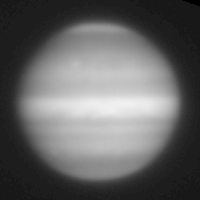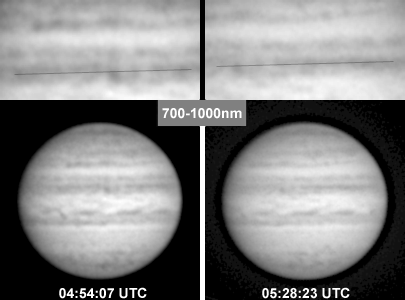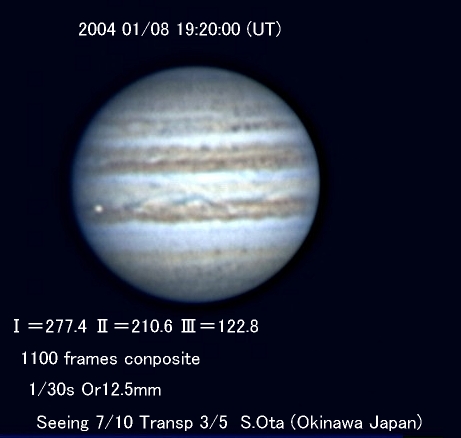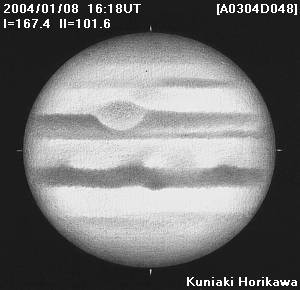|
Antonio Cidadao (250mm LX200SCT : FLICM7 1E CCD camera)
|

Hi again
Here is the methane (889nm/18nm) animation produced from the corrected
(otherwise non-processed) raws obtained on Jan8. Conventional image data
will be sent soon.
Please notice the wavy apearence of the EZ, which is more extensive than the
NEBs projections themselves, and the dark patches near NPR.
Although much more difficult to visualize, try to see the slightly darker
and very broad band that goes from the equator to the SPH (as if it was a
1/4 meridian). It does rotate with the planet, and, I recall, is seen in
flat corrected images.
Good observations
Antonio
Hi all
I'm attaching some recent data, obtained on Jan 08 2004, regarding the
colocalization of methane-bright features on Jupiter and those observed on
broadband IR imaging. I had already seen similar things with the 5nm filter
but with the 18nm FWHM filter it brings about a new issue: is that filter
significantly showing deep cloud decks?
I had mentioned this, by the way, in a previously message, but I'm now
showing some pictures. The observation is that with carefull registration of
CH4 and IR images, confirmed by the colocalization of relevant planetary
features, (some) CH4-bright rifts in mid SEB are IR-dark, and vice versa.
This (finding of some IR-bright rifts being CH4-dark) does not support
significant deep-cloud detection even with the 18nm FWHM methane filter. On
the other hand, this kind of signal association looks pretty similar to
recent SE-disturbance events and may be interesting to further follow or
explore. Conversely, the ocurrence of bright CH4 rifts over IR-dark regions
on belts may also be interesting with respect to high altitude circulation
events.
To allow the most perfect colocalization possible between IR images and CH4
images, that is to be able to ascribe them the same time data, I used
precisely the same approach applied to the two methane filters. In this case
a series of nine 30 sec integrations where frame no.5 was the obtained with
the IR filter; all other symetrically positioned eitght frames were produced
with the methane filter.
Data shown have S up and p. to the left, and two sets of images are
presented in a "blink"-like animation. Above the whole disk images is a
blow-up of a region containing the SEB, and to ease the conclusions I
superimposed a couple of immotile faint lines.
This is a nice project to develop all around the SEB, preferentially with
good seeing, when Jupiter gets bigger and with inquestionable "internal
controls" for image registration like sattelite shadows or satellites
themselves. I'm pretty convinced of the data so far, but one has to doubt by
default :-)
Good observations
Antonio
 ≪アントニオ シダダオ ポルトガル≫
[Antonio Cidadao Oeiras - Portugal]
≪アントニオ シダダオ ポルトガル≫
[Antonio Cidadao Oeiras - Portugal]
 ALPO-Japan Latest ALPO-Japan Latest

 Jupiter Section Jupiter Section
|






≪アントニオ シダダオ ポルトガル≫ [Antonio Cidadao Oeiras - Portugal]
 ALPO-Japan Latest
ALPO-Japan Latest

 Jupiter Section
Jupiter Section